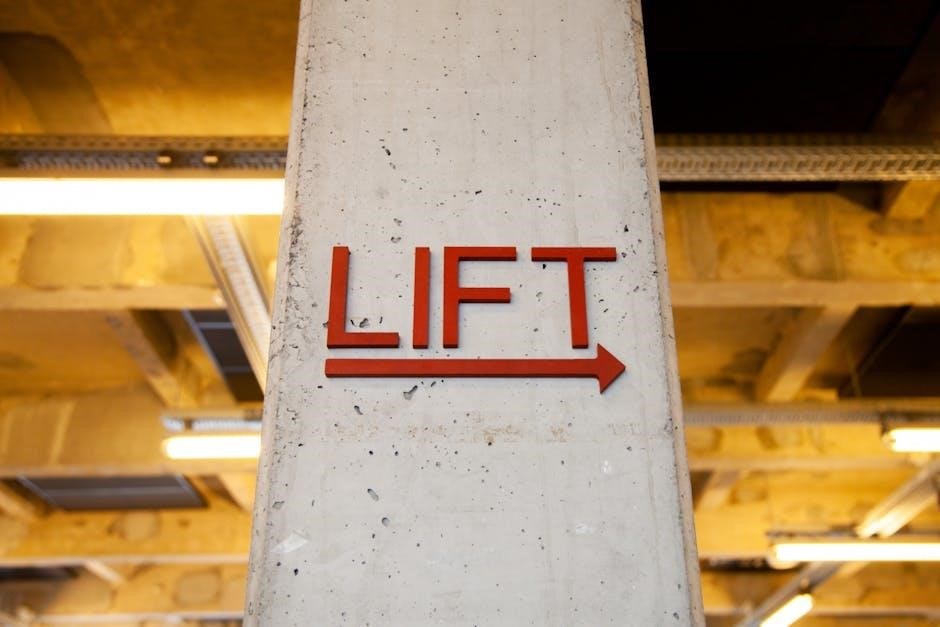The Eopa Study Guide for Construction Management is a comprehensive resource designed to equip professionals with essential knowledge and skills for successful project execution․ It covers key areas such as project planning, cost management, and construction scheduling, ensuring adherence to safety standards and best practices․ This guide is tailored to help professionals deliver projects efficiently and safely․
Overview of the Eopa Study Guide
The Eopa Study Guide for Construction Management provides a comprehensive overview of modern construction practices, focusing on project planning, cost estimation, and risk management․ It emphasizes practical approaches to ensure efficiency and safety in construction projects․ The guide covers key topics such as construction scheduling, safety protocols, and sustainability practices, offering insights into real-world applications․ Designed for professionals, it serves as a valuable resource for mastering construction management principles and staying updated on industry standards․
Importance of Construction Management in Modern Projects
Construction management is crucial for ensuring projects are completed efficiently, safely, and sustainably․ It plays a vital role in modern projects by optimizing resource allocation, minimizing risks, and ensuring compliance with regulations․ Effective construction management enhances collaboration among stakeholders, improving overall project outcomes․ By implementing best practices, it helps deliver projects on time, within budget, and to the required quality standards, making it indispensable in today’s complex construction landscape․

Key Concepts in Construction Management
Construction management encompasses essential concepts like project planning, cost estimation, and scheduling․ It ensures efficient resource utilization, risk mitigation, and quality assurance, forming the backbone of successful project delivery․
Project Planning and Control
Project planning and control are critical components of construction management, ensuring projects are completed on time and within budget․ This involves defining objectives, creating detailed timelines, and allocating resources effectively․ Proper planning helps identify potential risks early, allowing for proactive mitigation strategies․ Control mechanisms, such as monitoring progress and adjusting schedules, ensure adherence to project goals․ Effective planning and control also enhance collaboration among team members, fostering a cohesive and efficient workflow․ These practices are essential for delivering successful construction projects․
Cost Estimation and Budgeting
Cost estimation and budgeting are fundamental processes in construction management, ensuring projects are financially viable and executable․ Accurate cost estimation involves analyzing materials, labor, and equipment expenses, while budgeting allocates resources to meet project goals․ Effective budgeting ensures adherence to financial constraints, minimizing overspending․ Construction managers use various methodologies, such as bottom-up or analogical estimating, to create detailed cost plans․ These practices are essential for maintaining project profitability and stakeholder confidence, ensuring seamless execution from planning to completion․
Construction Scheduling and Timelines
Construction scheduling involves creating detailed timelines to ensure projects are completed on time․ It includes breaking down tasks into manageable components, assigning durations, and sequencing activities․ Tools like Gantt charts and Critical Path Method (CPM) help visualize and manage timelines․ Effective scheduling ensures resource allocation, minimizes delays, and aligns with project milestones․ Accurate timelines are crucial for maintaining order, meeting deadlines, and delivering projects efficiently; Construction managers must regularly monitor and adjust schedules to adapt to changes or unexpected challenges․
Roles and Responsibilities in Construction Management
Construction management involves overseeing projects from planning to completion․ Key roles include project managers, contractors, and architects, each responsible for specific tasks like scheduling, execution, and design compliance․
Project Manager’s Role
The project manager oversees all aspects of construction projects, ensuring timely delivery within budget․ Responsibilities include coordinating teams, managing resources, and mitigating risks․ They develop schedules, monitor progress, and communicate with stakeholders․ Effective project managers ensure compliance with plans and quality standards while addressing challenges promptly․ Strong leadership, organizational, and problem-solving skills are essential for success in this critical role․
Contractor’s Responsibilities
Contractors are responsible for executing construction work as per agreed plans and specifications․ They oversee labor, materials, and equipment, ensuring compliance with safety and quality standards․ Contractors must obtain necessary permits, manage subcontractors, and adhere to project timelines․ They are accountable for resolving unforeseen site issues and delivering work that meets contractual obligations․ Effective communication with clients and project managers is crucial to ensure smooth project execution and address potential disputes promptly․
Architect and Engineer’s Contributions
Architects and engineers play a vital role in construction management by designing and planning projects․ They create detailed blueprints, specifications, and technical documents to guide construction․ Their expertise ensures designs are functional, safe, and meet regulatory standards․ They collaborate with contractors and project managers to address technical issues and ensure compliance with plans․ Their contributions are essential for translating creative visions into executable and structurally sound projects, balancing aesthetics with practicality and safety․

Construction Processes and Methods
Construction processes involve planning, execution, and handover phases, utilizing techniques like lean construction and BIM for efficient project management and compliance with industry standards․
Pre-Construction Planning
Pre-construction planning is the foundational phase where projects are conceptualized and organized․ It involves site analysis, feasibility studies, budgeting, and permitting․ Key activities include defining the project scope, designing preliminary plans, and assessing risks․ This phase ensures compliance with regulations and stakeholder expectations․ Effective pre-construction planning minimizes delays and cost overruns by identifying potential issues early․ It sets the stage for smooth execution and involves coordination among architects, engineers, and contractors to create a detailed project roadmap․
Execution Phase of Construction
The execution phase involves the actual construction work, where plans are implemented on-site․ Key activities include site preparation, material procurement, and resource allocation․ Contractors and subcontractors execute tasks as per approved designs and schedules․ Safety protocols and quality standards are rigorously enforced․ Regular monitoring ensures adherence to timelines and budgets․ Effective communication and coordination among stakeholders are critical during this phase․ Proper documentation and continuous oversight are essential to maintain project progress and address any unforeseen challenges promptly․
Project Handover and Closeout
The project handover and closeout phase marks the completion of construction․ It involves final inspections, snag list resolution, and obtaining necessary certifications․ Documentation, including as-built plans and operational manuals, is transferred to the client․ Training is provided to the client’s team for facility management․ The contractor demobilizes, and the site is handed over formally․ This phase ensures all contractual obligations are met, disputes resolved, and final payments processed, concluding the project lifecycle successfully․

Tools and Techniques for Effective Construction Management
Construction management employs tools like project management software, BIM, and Gantt charts for scheduling and tracking․ Techniques include lean construction, quality control, and risk management methodologies․
Construction Management Software
Construction management software streamlines project oversight, offering tools for scheduling, budgeting, and collaboration․ Programs like Procore and Autodesk enable real-time tracking of progress, resource allocation, and issue resolution․ These platforms integrate with BIM models, enhancing accuracy and communication․ Key features include task assignment, RFIs, and document control, ensuring transparency and efficiency across teams․ By centralizing data, software reduces errors and improves decision-making, making it indispensable for modern construction projects․
Project Monitoring and Reporting Tools
Project monitoring and reporting tools are essential for tracking progress and generating insights in construction management․ These tools enable real-time tracking of tasks, resources, and timelines, ensuring projects stay on schedule․ Automated reporting features provide detailed status updates, helping stakeholders make informed decisions․ By identifying potential delays and deviations, these tools facilitate proactive adjustments․ They also enhance transparency and communication among team members, ensuring alignment and accountability throughout the project lifecycle․
Quality Control and Assurance Techniques
Quality control and assurance techniques ensure that construction projects meet specified standards and requirements․ These methods involve systematic inspections, testing, and audits to verify compliance with plans and regulations․ Continuous monitoring helps identify and address defects early, minimizing rework․ Documentation and corrective action plans are critical for maintaining accountability․ By implementing these practices, construction teams can deliver high-quality outcomes, enhance customer satisfaction, and uphold project integrity․ These techniques are vital for maintaining consistency and excellence throughout the construction process․

Safety Management in Construction
Safety management in construction involves implementing OSHA regulations, safety protocols, and risk assessments to ensure compliance and safe working conditions․ Proper training and equipment are essential․
OSHA Regulations and Compliance
OSHA regulations are critical for ensuring workplace safety in construction․ These standards provide guidelines for safe practices, training, and equipment use․ Compliance is mandatory to avoid legal penalties and ensure worker well-being․ Key areas include fall protection, electrical safety, and hazard communication․ Employers must document safety training and inspections․ Non-compliance can result in fines and legal actions․ Adhering to OSHA standards minimizes risks, enhances productivity, and fosters a culture of safety within construction projects․
Safety Protocols and Best Practices
Safety protocols and best practices are essential in construction management to minimize risks and ensure a safe working environment․ Key protocols include the use of personal protective equipment (PPE), regular safety drills, and proper equipment maintenance․ Best practices involve conducting routine safety audits, promoting a safety-first culture, and providing comprehensive training to all workers․ Adhering to these standards ensures compliance with regulations and enhances overall project efficiency and worker well-being․
Risk Assessment and Hazard Control
Risk assessment and hazard control are critical components of construction management․ They involve identifying potential dangers, evaluating their likelihood and impact, and implementing measures to mitigate risks․ Hazard control strategies include elimination, substitution, engineering controls, and administrative measures․ Regular site inspections and hazard reporting systems help maintain safety․ Effective risk management ensures compliance with safety standards, reduces accidents, and protects personnel and assets․ Continuous monitoring and adaptation of control measures are essential for dynamic construction environments․

Quality Management in Construction
Quality management in construction ensures projects meet specified standards through systematic processes, focusing on materials, workmanship, and compliance to deliver a final product meeting client expectations․
Quality Assurance vs․ Quality Control
Quality assurance (QA) focuses on establishing systematic processes to ensure project requirements are met, while quality control (QC) involves monitoring and inspecting work to maintain standards․ QA is proactive, setting frameworks for quality, while QC is reactive, identifying and correcting defects․ Together, they ensure construction projects deliver defect-free results, adhering to specifications and regulations․ Understanding their roles is crucial for maintaining high standards and client satisfaction in construction management․
Standards and Specifications
Standards and specifications are critical in construction management, ensuring materials, methods, and finishes meet project requirements․ Standards, set by organizations like ASTM or ISO, provide uniform guidelines․ Specifications outline exact requirements for materials and workmanship․ Adhering to these ensures compliance with legal, safety, and quality expectations․ Project managers must enforce these standards to maintain consistency and minimize defects, ensuring the final product aligns with design and functional objectives․ Proper documentation is key to verification and compliance tracking․
Defect Management and Rectification
Defect management involves identifying, documenting, and resolving deficiencies in construction work․ Early detection through inspections and testing is crucial․ Defects are categorized based on severity, with critical issues requiring immediate attention․ Rectification involves corrective actions, repairs, or replacements to meet specifications․ Proper documentation and communication ensure accountability․ A structured defect management process minimizes delays, ensures quality, and maintains project integrity․ Effective rectification planning is essential for timely project completion and client satisfaction․

Contract Administration and Legal Issues
Contract administration involves managing agreements, ensuring compliance, and addressing legal matters․ It includes contract interpretations, payment processes, and change orders, minimizing disputes and ensuring smooth project execution․
Types of Construction Contracts
Construction contracts vary based on payment structures and project requirements․ Common types include lump-sum contracts, where a fixed price is agreed upon, and cost-plus contracts, which reimburse actual costs plus a fee․ Unit-price contracts are based on predefined unit rates for specific items․ Design-build contracts integrate design and construction services, while time-and-material contracts are used for smaller, undefined scopes․ Each type balances risk, cost, and flexibility, ensuring alignment with project goals and stakeholder expectations․
Contract Negotiation and Documentation
Effective contract negotiation ensures clarity and alignment of expectations between all parties․ It involves discussing terms, deliverables, and payment structures to reach mutually acceptable agreements․ Proper documentation is critical, detailing roles, responsibilities, timelines, and payment terms․ Contracts must comply with legal standards, protecting all stakeholders․ Clear communication and thorough documentation prevent disputes and ensure smooth project execution․ Well-drafted contracts serve as a reference point for resolving conflicts and maintaining accountability throughout the project lifecycle․
Dispute Resolution and Claims Management
Dispute resolution and claims management are crucial for maintaining project continuity․ Disputes often arise from scope changes, delays, or payment issues․ Effective resolution involves mediation, arbitration, or negotiation to reach mutually acceptable solutions․ Claims management ensures that all parties’ rights are protected, with proper documentation and legal frameworks in place․ Timely resolution minimizes delays and cost overruns, fostering collaboration and trust among stakeholders․ Clear communication and structured processes are essential for managing disputes efficiently and maintaining project momentum․

Risk Management in Construction Projects
Risk management in construction involves identifying and mitigating potential threats to ensure project success, using strategies and contingency plans to minimize impacts on time, cost, and quality․
Identifying Potential Risks
Identifying potential risks involves analyzing environmental, operational, and financial factors that could impact the project․ Common risks include delays, cost overruns, safety hazards, and design flaws․ Regular site inspections, stakeholder feedback, and historical data analysis help pinpoint vulnerabilities․ Early identification allows proactive planning to mitigate threats, ensuring project stability and success․ This step is critical for developing effective risk management strategies tailored to the project’s unique conditions and requirements․
Risk Assessment and Mitigation Strategies
Risk assessment evaluates the likelihood and impact of identified threats, prioritizing them for mitigation․ Strategies include transferring risks through insurance or contracts, reducing likelihood via safety measures, and accepting manageable risks․ Contingency plans are developed for high-priority risks, ensuring preparedness․ Regular monitoring and reviews ensure strategies remain effective․ Proactive risk management enhances project resilience, minimizing disruptions and ensuring objectives are met efficiently․
Crisis Management and Contingency Planning
Crisis management involves responding to unforeseen events to minimize impacts on projects․ Contingency planning creates backup strategies for potential disruptions, ensuring continuity․ Key elements include emergency protocols, resource allocation, and communication plans․ Regular reviews and simulations test readiness․ Effective contingency planning reduces downtime, supports stakeholder confidence, and ensures projects recover swiftly from crises, maintaining overall objectives and timelines․

Environmental Considerations and Sustainability
Construction projects must address environmental impacts, adopting sustainable practices to reduce waste and resource consumption․ This ensures eco-friendly outcomes while meeting regulatory standards and promoting long-term stewardship․
Environmental Impact Assessment
Environmental Impact Assessment (EIA) evaluates potential environmental effects of construction projects․ It identifies risks to ecosystems, water, and air quality, ensuring compliance with regulations․ Conducting EIAs helps mitigate negative impacts by proposing alternative solutions․ Early assessment enables sustainable planning, reducing long-term environmental damage․ Stakeholders use EIA reports to make informed decisions, balancing development needs with ecological preservation․ This process is crucial for obtaining permits and demonstrating commitment to environmental responsibility in construction projects․
Sustainable Construction Practices
Sustainable construction practices focus on minimizing environmental impact while optimizing building performance․ Key strategies include using renewable materials, energy-efficient systems, and waste reduction techniques․ Implementing green technologies, such as solar panels and rainwater harvesting, enhances sustainability․ Buildings designed for longevity and adaptability reduce long-term resource consumption․ These practices not only lower carbon emissions but also promote cost savings and improved occupant health․ Adopting sustainable methods ensures projects align with environmental goals and support eco-friendly development․ Proper planning and execution are essential for successful implementation․
Green Building Certifications
Green building certifications, such as LEED (Leadership in Energy and Environmental Design) and BREEAM (Building Research Establishment Environmental Assessment Method), recognize structures that meet high sustainability standards․ These certifications evaluate energy efficiency, water conservation, and material use․ Achieving certification enhances a building’s market value and demonstrates commitment to environmental responsibility․ They also promote occupant health and reduce long-term operational costs, making them a key goal for sustainable construction projects․ Certifications are awarded based on rigorous performance criteria and independent assessments․

Case Studies and Real-World Applications
Case studies and real-world applications are essential for construction management education․ They provide practical insights into project planning, execution, and outcomes, enhancing management skills and decision-making abilities․
Success Stories in Construction Management
Success stories in construction management highlight projects that achieved exceptional results through effective planning and execution․ For example, the Burj Khalifa, completed ahead of schedule, exemplifies innovative project management․ Similarly, the London Olympics 2012 demonstrated efficient coordination, delivering all venues on time and within budget․ These cases showcase the importance of collaboration, risk management, and adherence to best practices, providing valuable insights for aspiring professionals studying with the Eopa guide․
Lessons Learned from Failed Projects
Failed construction projects provide valuable insights into common pitfalls․ The Leaning Tower of Pisa, for instance, highlights the consequences of inadequate foundation planning and soil analysis․ Similarly, the Sydney Opera House faced significant delays and cost overruns due to design complexities and communication breakdowns․ These examples emphasize the importance of thorough planning, effective risk management, and clear stakeholder communication․ Learning from such failures is crucial for improving construction management practices and avoiding similar mistakes in future projects․
Best Practices in Construction Management
Effective construction management relies on several best practices to ensure project success․ Clear communication and collaboration among stakeholders are essential to avoid misunderstandings․ Detailed planning, including timelines and budgets, helps maintain project alignment․ Regular monitoring and adaptability to changes are crucial for timely delivery․ Implementing safety protocols and quality control measures ensures compliance and minimizes risks․ Leveraging technology, such as construction management software, enhances efficiency and transparency․ These practices collectively contribute to successful project outcomes and stakeholder satisfaction․
Preparing for the Eopa Certification Exam
Preparing for the Eopa certification exam involves understanding the format, developing a study plan, and utilizing practice questions to ensure success․
Exam Format and Content
The Eopa certification exam typically consists of multiple-choice questions and case studies, assessing knowledge in construction management, safety protocols, and contract administration․ The exam format includes 100-150 questions, with a time limit of 3-4 hours․ Content areas cover project planning, cost estimation, scheduling, risk management, and quality control․ Candidates must demonstrate practical understanding and problem-solving skills․ Familiarity with industry standards and best practices is crucial for success․ Understanding the exam format helps in tailoring study strategies effectively․
Study Tips and Strategies
To excel in the Eopa certification exam, focus on creating a structured study plan tailored to your learning style․ Prioritize understanding core concepts over memorization․ Practice active learning by solving problems and reviewing case studies․ Utilize mock tests to familiarize yourself with the exam format and identify weak areas․ Allocate time for regular revisions and maintain consistency in study sessions․ Engage with study groups or forums to discuss challenging topics and gain new insights․ Stay updated with industry trends to complement your preparation․
Practice Questions and Mock Tests
Practicing with sample questions and mock tests is essential for exam preparation․ These resources simulate real exam conditions, helping you assess your knowledge and time management․ Focus on understanding the question format and content depth․ Regularly attempt practice questions from the Eopa study guide and online platforms․ Review your answers to identify weak areas and improve accuracy․ Mock tests also help build confidence and reduce exam anxiety, ensuring you’re well-prepared for the actual certification exam․
The Eopa Study Guide equips professionals with comprehensive insights into construction management․ Emerging technologies like BIM, AI, and sustainable practices will shape the industry’s future, driving efficiency and innovation․
Emerging Technologies in Construction Management
Emerging technologies like Building Information Modeling (BIM), artificial intelligence, and the Internet of Things (IoT) are revolutionizing construction management․ These tools enhance project planning, monitoring, and execution․ AI streamlines scheduling and cost estimation, while IoT enables real-time site monitoring․ 3D printing and robotics are improving construction efficiency and safety․ These innovations are driving sustainability and reducing waste, ensuring projects align with modern demands for greener and smarter infrastructure․
The Future of Construction Management
The future of construction management lies in sustainability and digital transformation․ As demand for eco-friendly practices grows, green technologies and renewable energy integration will dominate․ Advanced data analytics and AI will optimize decision-making, while automation enhances efficiency․ Professionals must adapt to these trends to meet global infrastructure demands, ensuring projects are resilient, sustainable, and technologically advanced․ Staying updated with these evolving practices is crucial for long-term success in the field․
